Magnetoelectric materials
In "conventional" materials the electric polarization is
proportional to the electric field, and the magnetization is
proportional to the magnetic field. In the magnetoelectric materials
the electric polarization can be influenced by magnetic field and
the magnetization depends upon electric field. The magnetoelectric
effect is especially strong in materials with simultaneous electric and
magnetic order, so called multiferroics. A well studied example of
multiferroic materials is represented by spiral magnets, RMnO3
(R=Eu, Gd, Tb, Dy).
Recently we could show that the dynamics in multiferroic RMnO3
is governed by an excitation of e new type, the
electromagnon [Ref.].
Electromagnons arises from the hybridization of magnons
with lattice vibrations. Contrary to known magnetic excitations which
interact with magnetic field, the electromagnons are excited by
electric field of the electromagnetic wave [Ref.]. From the
spectroscopic point of view, the electromagnons are responsible for the
magnetodielectric effect in the static permittivity.
|
Spectrum of Electromagnons in GdMnO3
The application of an external magnetic field parallel to the c-axis removes the electromagnon contribution and leads to strong changes in the static dielectric constant [Ref.]. |
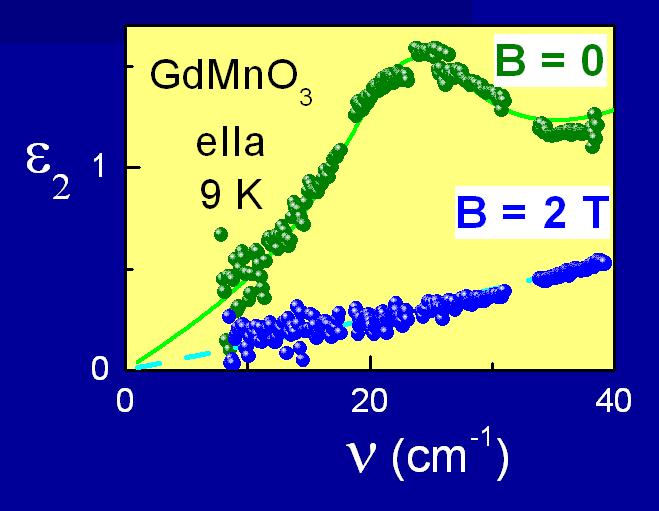
|
|
Permittivity spectrum of DyMnO3
Permittivity as a function of frequency and temperature at a constant magnetic field of 2T during a flop transition from P||c to P||a |
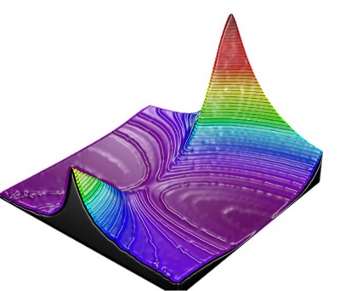
|
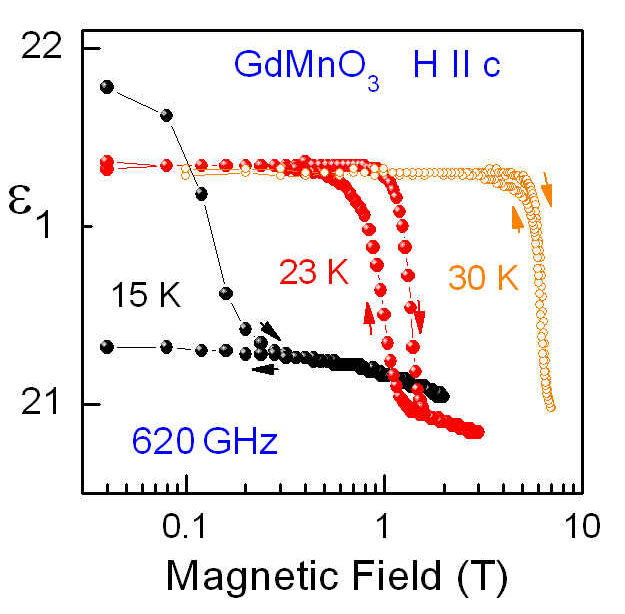
|
Magnetoelectric Effect in GdMnO3
|
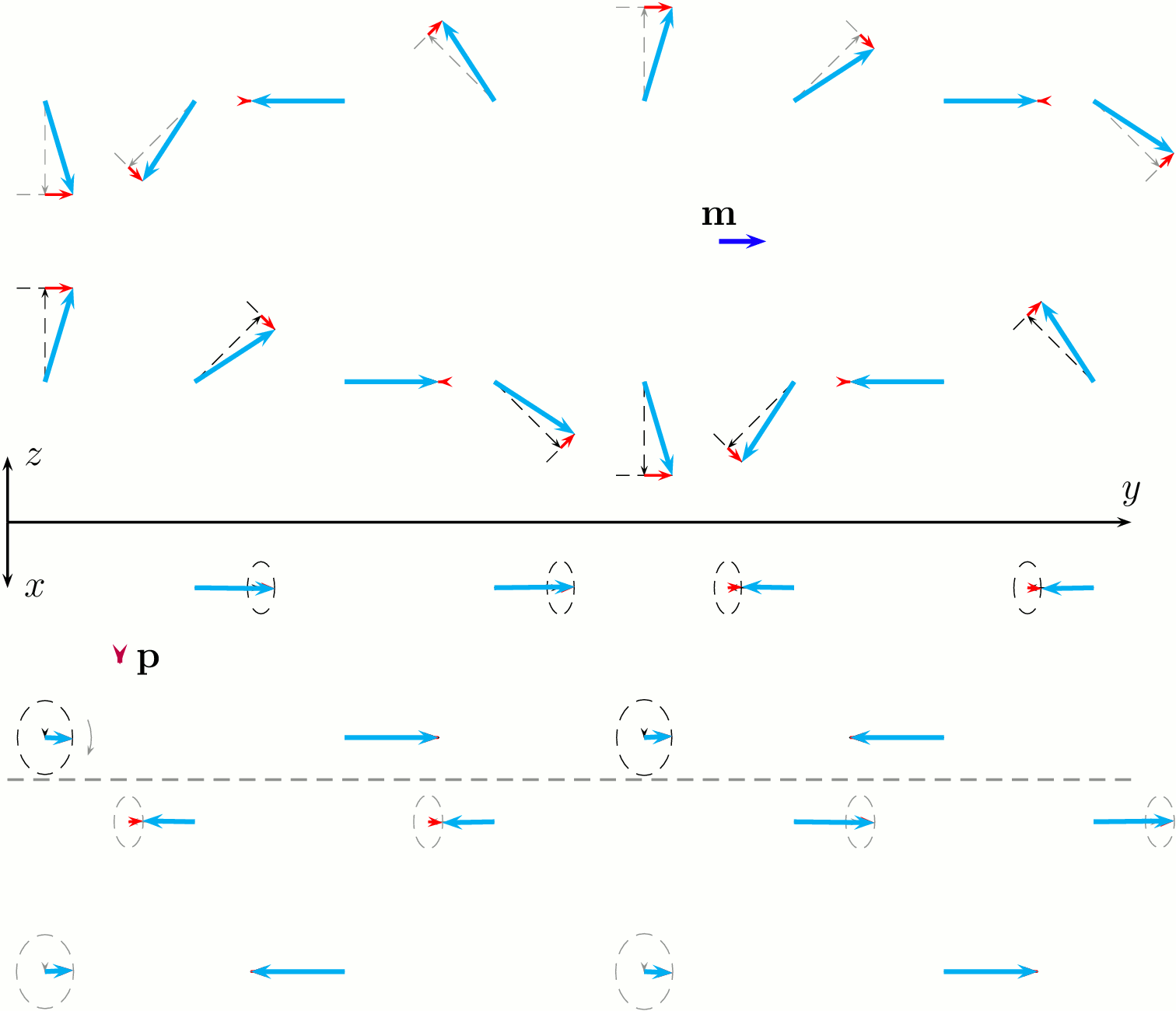
|
|
Symmetric combination of magnons Schematic representation of symmetric combination of magnons with q=±Q in the cycloidal antiferromagnet. The black dashed arrows represent the ground state, the cyan thicker arrows - orientations of spins in a wave and red arrows are the deviations of spins from their equilibrium orientations. Upper panel is a front view, lower panel - top view. The upper row of spins in the front view and lower row of spins in the top view with equilibrium spin orientations in gray show spins in the next layer along the z direction. The spins in the co-rotating frame are moving along elliptical orbits (black dashed ellipses) as shown by the gray arrows. This mode is a standing wave with the nodes on the spins pointing along the y direction and it has nonzero dynamic magnetization along this axis shown by thick blue arrow. In the presence of IDM (Inverse Dzyaloshinskii-Moriya) interaction the mode also gains electric dipole along the x axis shown as a thick purple arrow |
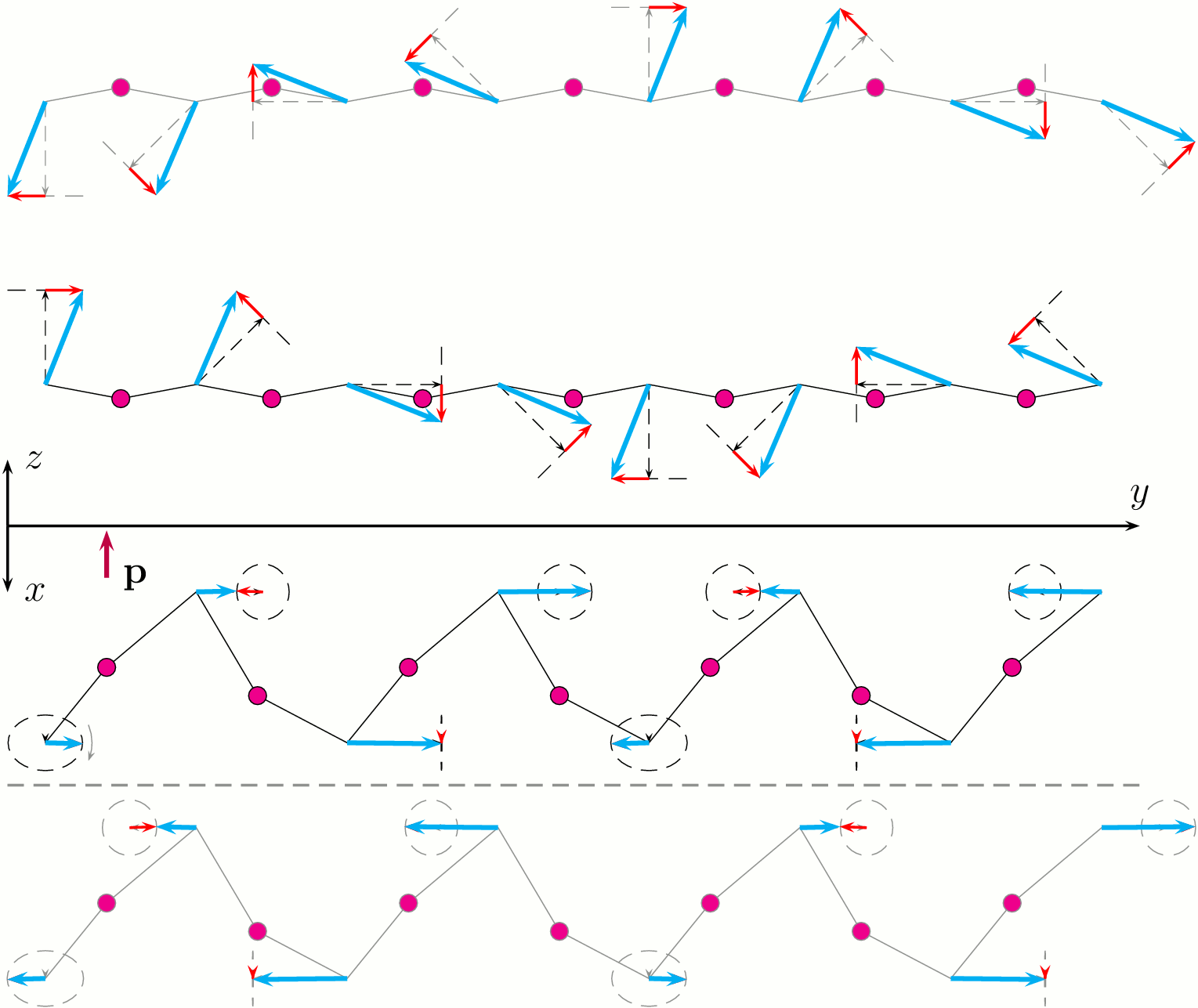
|
|
Magnon in the corner of Brillouin zone
Schematic representation of the magnon in the corner of the Brillouin zone in the cycloidal antiferromagnet. The notations are the same as in the upper figure with additional magenta circles representing oxygen atoms in MnO2 planes. The spins in the co-rotating frame are moving along elliptical orbits (black dashed ellipses) as shown by the gray arrow. In the presence of HE (Heisenberg Exchange) interaction the oxygen atoms move towards the center of Mn-O-Mn bond if the adjacent spins are almost collinear and in the opposite direction if spins are less aligned. The overall motion of oxygen atoms yields the electric dipole moment along the x axis shown as a thick purple arrow. |
Selected publications
-
A. M. Shuvaev, J. Hemberger, D. Niermann, F. Schrettle, A. Loidl, V. D. Travkin, V. Yu. Ivanov, A. A. Mukhin, and A. Pimenov
Soft-mode behavior of electromagnons in multiferroics
Phys. Rev. B 82, 174417 (2010) [cond-mat/1007.4727] -
A. M. Shuvaev, V. D. Travkin, V. Yu. Ivanov, A. A. Mukhin, and A. Pimenov
Evidence of electro-active excitation of the spin cycloid in TbMnO3
Phys. Rev. Lett. 104, 097202 (2010) [cond-mat/1001.1148]
-
A. Pimenov, A. Shuvaev, A. Loidl, F. Schrettle, A. A. Mukhin, V. D. Travkin, V. Yu. Ivanov, and A. M. Balbashov
"Magnetic and magnetoelectric excitations in TbMnO3
Phys. Rev. Lett. 102, 107203 (2009) [cond-mat/0902.4382]
-
A. Pimenov, A. Loidl, A. M. Shuvaev, and A. A. Mukhin
Electromagnons in multiferroic manganites
J. Phys.: Cond. Matter 20, 434209 (2008) -
A. Pimenov, A. A. Mukhin, V. Yu. Ivanov, V. D. Travkin, A. M. Balbashov, and A. Loidl
Possible evidence for electromagnons in multiferroic manganites
Nature Physics 2, 97 (2006) [cond-mat/0602173] -
A. Pimenov, T. Rudolf, F. Mayr, A. Loidl, A. A. Mukhin, and A. M. Balbashov
Coupling of phonons and electromagnons in GdMnO3
Phys. Rev. B 74, 100403(R) (2006) [cond-mat/0605523]

